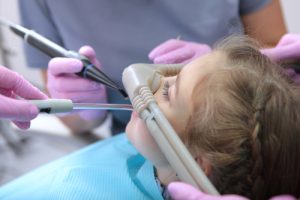A type of dental care called sedation dentistry, commonly referred to as sleep dentistry, makes use of medicine to make patients more at ease and relaxed throughout their dental procedure. Sedation dentistry aims to give patients who suffer anxiety or dread when visiting the dentist a safe and comfortable experience.
Oral sedation, nitrous oxide (laughing gas), and IV sedation are just a few of the sedative techniques that can be utilized in dentistry. The most prevalent type of sedation used in dentistry is oral sedation. Prior to the surgery, the patient must take a pill—typically a moderate sedative. The patient is still cognizant and able to converse with the dentist while taking the tablet, which promotes relaxation and calmness. 
Another type of sedation that is inhaled through a mask is nitrous oxide, also known as laughing gas. It is a modest form of sedation that may lessen discomfort and anxiety during the treatment. IV sedation, also referred to as conscious sedation, is a more intense type of sedation that is given intravenously. Usually, longer operations or individuals with extreme anxiety require this kind of sedation.
Patients with dental phobia commonly referred to as dread of the dentist, benefit greatly from sedation dentistry. Numerous things, such as a negative dental experience in the past, a fear of pain, or a fear of needles, can contribute to this phobia. These anxieties can be reduced with sedation dentistry, which will also make the patient feel more at ease during their dental visit. Patients with a sensitive gag reflex, trouble numbing, or trouble staying still in the dental chair can also benefit from it.
Patients who require many operations at once can also benefit from sedation dentistry. Patients who require considerable dental work, such as many fillings, extractions, or root canals, may fall under this category. Sedation can shorten the procedure’s duration and increase the patient’s comfort.
It’s crucial to understand that while sedation helps ease dental procedures, local anesthetic is still required in some cases. Local anesthetic is still required to numb the area being worked on and prevent pain throughout the process.
Sedation dentistry’s safety is of utmost importance. Therefore, sedation dentistry is only performed by dentists who have received specialized training and hold a license to do so. In order to make sure the patient is safe and comfortable throughout the treatment, they will also keep a careful eye on them.
In conclusion, sedation dentistry is a secure and efficient technique to give patients a relaxing and anxiety-free dental session. It can help individuals who struggle to stay still in the dental chair, have a sensitive gag reflex, are afraid of the dentist, or have trouble numbing up. Patients who require many procedures to be completed at once can also use it. Sedation dentistry is a secure and reliable method of increasing the patient’s comfort during dental procedures.